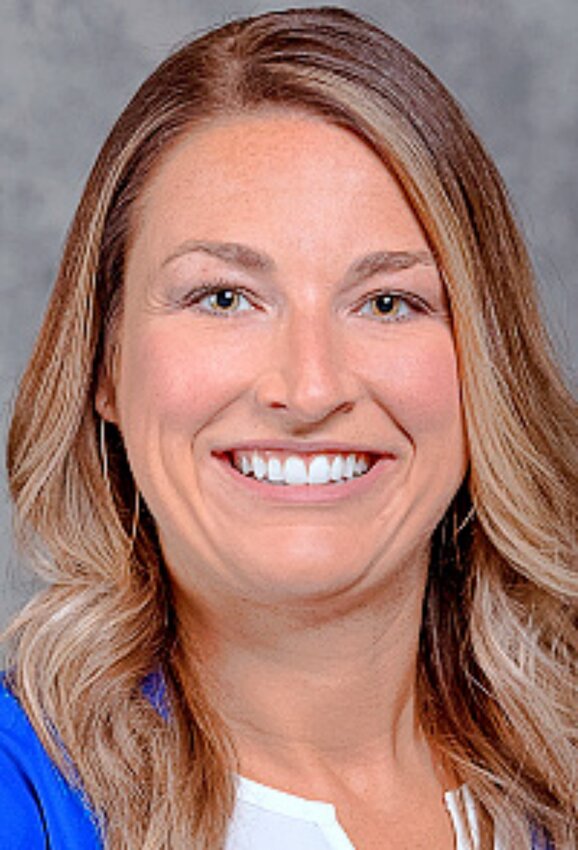SDSU Marketing & Communications
BROOKINGS — Healthcare simulation is an important tool for filling gaps in nursing education, and the South Dakota State University School of Nursing is one of the region's leaders in both simulation education and simulation research.
However, simulation remains an emerging tool and continues to undergo necessary updates and changes to continually improve learning outcomes for future healthcare professionals. Brittany Brennan, a new faculty member in SDSU's College of Nursing, is working to advance the field of simulation education with the International Nursing Association's Project on Clinical Simulation and Learning.
“I am a member of a committee that is working on updating the Simulation Facilitation Standards,” said Brennan, an assistant professor at the university. “This is a large project, but ultimately we plan to publish new standards to facilitate simulation.”
As part of a multi-year project, Brennan and colleagues will review all available research on the effects of simulation facilitation on learning outcomes. They plan to use their research to establish a modern set of standards to be used by certified simulation centers around the world.
The research team will examine more than 6,000 research papers to explain the science underlying simulation facilitation and its impact on medical learners. The findings will be used to identify criteria for an updated set of standards.
This work is necessary to ensure that certified simulation centers, such as SDSU's Healthcare Simulation Center, are following the best practices available for simulation education.
This is in stark contrast to just over a decade ago, when simulation was a relatively new tool to help educate future medical professionals. The purpose was to give students the opportunity to experience clinical situations and scenarios without interacting with real patients. These were particularly important for students to learn and deal with unique and rare situations that are difficult to imitate in clinical settings. However, as Brennan explains, his simulation scenarios at the time did not follow best practices or a set of standards, creating a chaotic and anxiety-filled situation for students.
“Students received their medical records, went into a room, and were then told to more or less figure it out,” Brennan said. “This was not a very safe learning environment and actually caused a lot of anxiety and students were not able to learn as much.”
Ultimately, major simulation associations, through the work of researchers like Brennan, developed a set of standards and processes that reduced scenario confusion and led to improved learning outcomes.
“Simulation standards are important because they laid the foundation for the various stages of simulation that are now expected,” Brennan said. “So now we have a pre-briefing standard, which is the first step in the simulation to make sure the students are fully prepared to participate in the simulation.”
The prebriefing process is where Brennan focused much of his previous research. While pursuing a PhD at SDSU, the available literature does not identify prebriefing standards or implementation strategies for simulation facilitators to conduct prebriefings in a manner that is considered “best practice.” I realized that.
In a 2022 research paper, “The Effects of Self-Efficacy-Based Pre-Briefing on Nursing Students' Clinical Competence and Self-Efficacy in Simulation: An Experimental Study,” Brennan describes a specific pre-briefing method, Self-Efficacy-Based Pre-Briefing. A study was conducted to demonstrate the model. Effective in promoting students' clinical competency and confidence.
This study highlights the evolution of simulation education as a whole and the need for simulation research. As Brennan previously pointed out, when she began work on her paper, prebriefings were not widely used in the simulation process. Nowadays, thanks to a set of simulation standards, pre-briefing, along with simulation and debriefing, has become an important stage of simulation education and is used in certified simulation centers.
“Dr. Brennan is a great addition to our team of simulation experts,” said Sarah Molman, associate dean for research in the SDSU College of Nursing. “Her innovation and dedication to evidence-based education are paramount in preparing the next generation of nurses for a variety of health environments, as well as educating them in a safe learning environment.”
Brennan received her Doctor of Nursing degree from SDSU in 2021 and was hired as a full-time faculty member in 2022. While she currently teaches nursing classes at the university, she is also working on clinical simulation for the International Nursing Association and the aforementioned standards project with the International Nursing Association. learn. In the future, Brennan hopes to collaborate with faculty at SDSU's Jerome J. Lohr School of Engineering to conduct research on the use of eye-tracking devices in virtual reality simulations.
Prior to arriving at Brookings, Brennan worked as a registered nurse in the Prairie Lakes Healthcare System Critical Care Unit in Watertown and also served as a nursing instructor at Lake Area Technical College.


